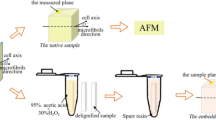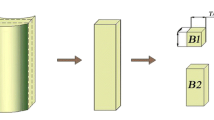Summary
The spore wall in the smut fungus Entorrhiza has been investigated, with particular reference to layer 3. The wall is stratified into four layers, numbered 1–4 from the outside to inside of the wall. Layer 3 has a lamellated or striated organization, depending on the type of specimen preparation used for examination. In this study, thin sectioning and freeze-etching methods were used in transmission electron microscopy. Layer 3 is approximately 50 nm thick and is the narrowest layer of the wall. Thin sections viewed at high magnification show a lamellated organization, consisting of alternate electron dense and translucent spaces. Usually between 16–20 lamellae form the layer, with a lamella having a thickness of about 1–2 nm. At high resolution, each electron dense lamella is resolved as a row of closely packed subunits, approximately 1.5 nm in diameter. The electron translucent lamellae probably represent mainly lipoidal material, which is extracted during specimen preparation. In freeze-etch preparations layer 3 is termed the “striated layer”. Fracturing exposes face views of the layer, which at low magnification has a wrinkled appearance. At high magnification, layer 3 has a structure consisting of an irregular mosaic of striations. The striations in each area of the mosaic are arranged parallel, and regularly spaced 11–13 nm apart. Each area of the mosaic is separated from an adjacent area by a small step; this represents where the plane of fracture changed to a different level within layer 3. Fracturing probably occurs in the lipoidal region of the layer, corresponding to the electron translucent lamellae seen in thin section. At high magnification, the striations are resolved into subunit-like particles, approximately 1–2 nm in diameter. Layer 3 is believed to form an impervious region in the spore wall. Layer 3 in Entorrhiza closely resembles the “partition layer” reported in spores of other Tilletiaceae. This demonstration of a common wall layer strengthens the relationship between Entorrhiza and the rest of the Tilletiaceae. Entorrhiza is the only smut that forms galls on host roots.
Similar content being viewed by others
References
Allen JV, Hess WM, Weber DJ (1971) Ultrastructural investigations of dormantTilletia caries teliospores. Mycologia 63: 144–156
Branton D (1966) Fracture faces of frozen membranes. Proc Natl Acad Sci USA 55: 1048–1056
— (1967) Fracture faces of frozen myelin. Exp Cell Res 45: 703–707
—, Bullivant S, Gilula NB, Karnovsky MJ, Moor H, Mühlethaler K, Northcote DH, Packer L, Satir B, Satir P, Speth V, Staehelin LA, Steere RL, Weinstein RS (1975) Freeze-etching nomenclature. Science 190: 54–56
Bullivant S (1973) Freeze-etching and freeze-fracturing. In: Koehler JK (ed) Advanced techniques in biological electron microscopy. Springer, Berlin Heidelberg New York, pp 67–112
Cutler DF, Alvin KL, Price CE (1982) The plant cuticle. Academic Press, London (Linnean Society Symposium Series, no 10)
Deamer DW, Branton D (1967) Fracture planes in an ice-bilayer model membrane system. Science 158: 655–657
—, Leonard R, Tardieu A, Branton D (1970) Lamellar and hexagonal lipid phases visualized by freeze-etching. Biochim Biophys Acta 219: 47–60
Durán R, Fischer GW (1961) The genus Tilletia. Washington State University, Pullman
Fineran BA (1975) Freeze-etching and the ultrastructural morphology of root tip cells. Phytomorphology 25: 398–415
— (1978) Freeze-etching. In: Hall JL (ed) Electron microscopy and cytochemistry of plant cells. Elsevier/North-Holland, Amsterdam, pp 279–341
—, Condon JM (1988) The stabilization of latex in laticifers of the Convolvulaceae: application of freezing methods for scanning electron microscopy. Can J Bot 66: 1217–1226
—, Fineran JM (1984) Teliospores ofEntorrhiza casparyana (Ustilaginales): a correlated thin sectioning and freeze-fracture study of endogenously dormant spores. Can J Bot 62: 2525–2539
— — (1992) Teliospore wall structure in Entorrhiza (Tilletiaceae), and its relationship to taxonomy of the genus. Can J Bot 70: 1964–1983
—, Gilbertson JM (1980) Application of lanthanum and uranyl salts as tracers to demonstrate apoplastic pathways for transport in glands of the carnivorous plantUtricularia monanthos. Eur J Cell Biol 23: 66–72
—, Condon JM, Ingerfeld M (1988) An impregnated suberized wall layer in laticifers of the Convolvulaceae, and its resemblance to that in walls of oil cells. Protoplasma 147: 42–54
Fineran JM (1971) Entorrhiza C. Weber (Ustilaginales) in root nodules of Juncus and Scirpus in New Zealand. New Zealand J Bot 9: 494–503
— (1978 a) A scanning electron microscope study of teliospores in Entorrhiza C. Weber (Ustilaginales). Nova Hedwigia 29: 825–846
— (1978 b) A taxonomic revision of the genus Entorrhiza C. Weber (Ustilaginales). Nova Hedwigia 30: 1–67
— (1980) The structure of galls induced by Entorrhiza C. Weber (Ustilaginales) on roots of the Cyperaceae and Juncaceae. Nova Hedwigia 32: 265–284
— (1982) Teliospore germination inEntorrhiza casparyana (Ustilaginales). Can J Bot 60: 2903–2913
— (1983) Inoculation studies ofJuncus articulatus withEntorrhiza casparyana (Ustilaginales). Can J Bot 61: 1959–1963
Fischer GW (1951) The smut fungi. Ronald Press, New York
Gardner JS, Hess WM (1977) Ultrastructure of lipid bodies inTilletia caries teliospores. J Bacteriol 131: 662–671
—, Allen JV, Hess WM (1975) Fixation of dormant Tilletia teliospores for thin sectioning. Stain Technol 50: 347–350
Graham SO (1960) The morphology and chemical analysis of the teliospore of the bunt fungus (Tilletia controversa). Mycologia 52: 97–118
Hess WM, Gardner JS (1983) Development and nature of the partition layer inTilletia caries teliospore wall. J Bacteriol 154: 499–501
— — (1988) Spore wall structure of Karnal Bunt teliospores. In: Hess WM, Weber DJ, Singh RS, Singh US (eds) Experimental and conceptual plant pathology, vol 1. Oxford IBH Publishing, New Delhi, pp 55–67
—, Weber DJ (1976) Form and function in basidiomycete spores. In: Weber DJ, Hess WM (eds) The fungal spore, form and function. Wiley, New York, pp 643–714
Heumann H-G (1990) A simple method for improved visualization of the lamellated structure of cutinized and suberized plant cell walls by electron microscopy. Stain Technol 65: 183–187
Kolattukudy PE (1980) Bipolyester membranes of plants: cutin and suberin. Science 208: 990–1000
Nawaz MS, Hess WM (1987) Ultrastructure ofNeovossia horrida teliospores. Mycologia 79: 173–179
Roberson RW, Luttrell ES (1987) Ultrastructure of teliospore ontogeny inTilletia indica. Mycologia 79: 753–763
Spurr AR (1969) A low-viscosity epoxy resin embedding medium for electron microscopy. J Ultrastruct Res 26: 31–43
Sussman AS, Douthit HA (1973) Dormancy in microbial spores. Annu Rev Plant Physiol 24: 311–352
Turian G, Hohl HR (eds) (1981) The fungal spore: morphogenetic controls. Academic Press, London
Vánky K (1987) Illustrated genera of smut fungi. G Fischer, Stuttgart [Jülich J (ed) Cryptogamic studies, vol 1]
Vánky K (1992) Taxonomic studies on Ustilaginales IX. Mycotaxon 43: 417–425
Weber DJ, Hess WM (1975) Diverse spores of fungi. In: Gerhardt P, Costilow RN, Sadoff HL (eds) Spores VI. American Society for Microbiology, Washington, DC, pp 97–111
Willison JHM (1980) Freeze-fractured cuticles of plants. Plant Sci Lett 18: 121–126
Author information
Authors and Affiliations
Rights and permissions
About this article
Cite this article
Fineran, B.A. A lamellated striated layer in the spore wall of the smut fungus Entorrhiza (Ustilaginales). Protoplasma 173, 58–69 (1993). https://doi.org/10.1007/BF01378862
Received:
Accepted:
Issue Date:
DOI: https://doi.org/10.1007/BF01378862




